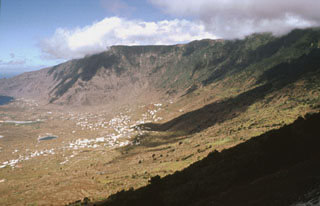Report on Hierro (Spain) — 7 September-13 September 2011
Smithsonian Institution / US Geological Survey
Weekly Volcanic Activity Report, 7 September-13 September 2011
Managing Editor: Sally Sennert.
Please cite this report as:
Global Volcanism Program, 2011. Report on Hierro (Spain) (Sennert, S, ed.). Weekly Volcanic Activity Report, 7 September-13 September 2011. Smithsonian Institution and US Geological Survey.
Hierro
Spain
27.73°N, 18.03°W; summit elev. 1500 m
All times are local (unless otherwise noted)
Instituto Geográfico Nacional (IGN) reported that since 16 July, seismicity at Hierro was high above the background levels. Until 7 September more than 6,200 events had been located, most of them in the El Golfo area with hypocenters that were 10 km deep, all magnitudes were below 3. The seismic activity alternated between relatively calm periods and high-energy periods. GPS local network stations showed deformations of about 2 cm. High rates of carbon dioxide flux were measured in the anomalous area.
Geological Summary. The triangular island of Hierro is the SW-most and least studied of the Canary Islands. The massive shield volcano is truncated by a large NW-facing escarpment formed as a result of gravitational collapse of El Golfo volcano about 130,000 years ago. The steep-sided scarp towers above a low lava platform bordering 12-km-wide El Golfo Bay, and three other large submarine landslide deposits occur to the SW and SE. Three prominent rifts oriented NW, NE, and S form prominent topographic ridges. The subaerial portion of the volcano consists of flat-lying Quaternary basaltic and trachybasaltic lava flows and tuffs capped by numerous young cinder cones and lava flows. Holocene cones and flows are found both on the outer flanks and in the El Golfo depression. Hierro contains the greatest concentration of young vents in the Canary Islands. Uncertainty surrounds the report of an eruption in 1793. A submarine eruption took place about 2 km SSW off the southern point of the island during 2011-12.

